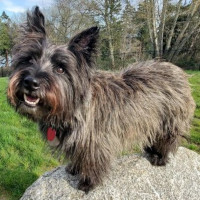Appearance of the Scottish-Skye Terrier
|
| The Scottish-Skye Terrier is a distinctive dog, small in stature with short legs, but long in body. This courageous dog has a double coat, the topcoat being hard and straight and the undercoat soft and short. Because it's low to the ground, it often looks as if it has no legs, just a long coat that skims the ground. Although you can't see much of their legs, they are well-boned and strong. Its chest is broad enough to support its powerful neck, while its long, elegant head has characteristic bangs and beard hairs, as well as hairy eyebrows. Skull and muzzle are generally of equal length, and feature a shiny black nose with wide-open nostrils and scissor-like teeth. The ears are either erect or drooping, and are often adorned with graceful feathers. The Scottish-Skye Terrier has a well-muscled, robust body, and its tail is of moderate length, thick at the root and tapering towards the tip. A unique and robust new breed, the Scottish-Skye Terrier quickly wins people's hearts and becomes a valuable companion, loyal and devoted to his family. |
Temperament of the Scottish-Skye Terrier
|
| Bold, spirited, full of life and with a great attitude, the Scottish-Skye Terrier is all this and more. They may be small and short-legged, but that's not how they see themselves at all: they have a big-dog attitude and the courage to match. Their adorable face adorned with bangs and whiskers makes them a popular choice, and it's hard to ignore their antics and serious expression. They make an ideal companion, loyal and faithful. While they may seem aloof and reserved to strangers, they're affectionate mischief-makers to their families. Dedicated owners roll their eyes at the sometimes stubborn character they can display, but admit that it's their unique personality that intrigues them most. These dogs don't see themselves as servants, but as equals, even if you have to be the boss, otherwise there'll be trouble. Praise and rewards will get you further with this dog than harsh words or commands. He will switch off if pushed too much. He's a gentle family dog, even if you have to watch him with the little ones. He won't tolerate being pushed, having his tail or ears pulled, or having his toys or food taken, and will retaliate with a warning bite or two. Apart from that, he makes a good playmate and a devoted dog. You'll be alerted as soon as a newcomer enters your property, and your Scottish-Skye Terrier will want for nothing. If you have a yard, make sure it's well fenced and secure, as this dog will relentlessly pursue any small furry animal. If you don't have a fence, say goodbye to your dog who disappears on the road. These dogs are not for inexperienced owners, as they can push to take control and try to organize their human, which can lead to all sorts of problems. Keep a firm grip on them and make sure you're the pack leader and all will be well. They make excellent companions and devoted pets for the right owner. |
Needs and activities of the Scottish-Skye Terrier
|
| These active little dogs keep busy, especially if they have a yard to patrol and protect from vermin, a task they take very seriously. But he'll still need a daily walk, which will be particularly useful for socializing this independent, bold dog who often doesn't seem to realize how small he is. He thinks like a big dog and has twice his weight in courage. These dogs love walks, but can be aloof and serious with people they meet. They like to take their time assessing strangers and, although not aggressive, can be protective. If you're looking for a dog to jog with, this is not the dog for you, as its short legs can tire easily. Similarly, he's not good in the water, as his short legs put him at a disadvantage, and he's been known to sink and almost drown in deep water. Keep the water level low to avoid tragedy. These dogs love to play with children, but they need to be supervised and taught not to push or hurt them, as they will retaliate with a bite or two. Games that challenge your dog's intellect are fun, while training should be based on mutual respect. These dogs are not servants, they are equals. Highly intelligent, affectionate and loyal to their family, they are unique and need a strong but fair companion and friend. |
Maintenance of the Scottish-Skye Terrier
|
| Scottish-Skye Terriers are relatively easy to care for, although their thick coats need to be brushed at least two or three times a week to prevent tangling and matting. While brushing, it's a good time to check your tough little dog for sores and scratches, as he can get into all sorts of places while satisfying his curiosity, and often injures himself as a result. Bathing is only necessary when necessary, as he's a remarkably clean dog, and unless he's rolled in mud or something smelly, a good brushing is usually enough. When washing him, use a mild dog shampoo to protect against skin allergies, and remember that these dogs aren't always the best swimmers because of their short legs, so don't lather them up and throw them in the water to rinse off, they may sink like a stone. Because of their long facial hair, check their eyes and ears for infection or oozing. Gently wipe these areas with a soft, damp cloth, then dry them thoroughly. Then brush their not-so-small white teeth and trim their nails, and they're ready for action. |









 English (United Kingdom)
English (United Kingdom)